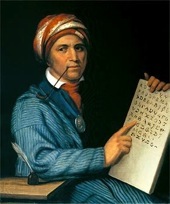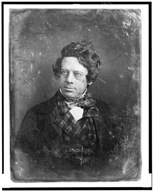In a peaceful valley setting near Tuskeegee, Tennessee, the warrior Sequoyah (a.k.a. George Gist) was born in 1776 to a Virginia fur trader and Cherokee mother. Sequoyah fled Tennessee as a youth because of the encroachment of whites, and moved to Georgia, where he acquired skills working with silver. He learned how to spell his name in English, and then began to toy with the idea of a Cherokee writing system that year(1809).
He enlisted in the Cherokee Regiment, fighting in the Battle of Horseshoe Bend, which effectively ended the war against the Creek Redsticks. It was during this conflict he felt compelled to make the Cherokees literate, as they were unable to write letters home, read military orders, or record events as they occurred. Using a phonetic system, where each sound made in speech was represented by a symbol, he created the "Talking Leaves", 85 letters that make up the Cherokee syllabary (he would later add another symbol, making the total 86). His own daughter quickly learned this form of communication, and word spread quickly of Sequoyah's invention. In 1821, 12 years after the original idea, the Cherokee Nation adopted Sequoyah's alphabet as their own. Within months thousands of Cherokee became literate.
In 1824 the National Council at New Echota struck a silver medal in his honor. Later, publication began on the first Native American newspaper, The Cherokee Phoenix in the same town. The painting of Sequoyah was made in 1828 on a trip to Washington to negotiate terms for removal from Arkansas to Oklahoma. Leaving the state in 1829, he had lived in Oklahoma for 10 years when Principal Chief John Ross led North Georgia Cherokee on the "Trail of Tears" to the state. He died in current day Texas in 1843 after possibly visiting family in a band of Chickamauga Cherokee who had moved there earlier.
Perhaps the most eloquent praise paid to Sequoyah was by H.A. Scomp, member of Emory College faculty, when he said "...perhaps the most remarkable man who has ever lived on Georgia soil was neither a politician, nor a soldier, nor an ecclesiastic, nor a scholar, but merely a Cherokee Indian of mixed blood. And strange to say, this Indian acquired permanent fame, neither expecting or seeking it."
To return to the home page, click here.









